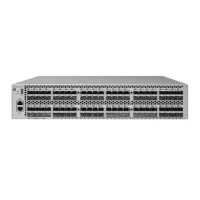• To restore the file from the first backup session, use the ADD DEFINE. You must specify the
GENERATION and VERSION. Otherwise, their default values would be for the latest backup
performed.
2> add define =DEF1, class tapecatalog, pool
WEEKLY_APPENDABLE, volcat
\CAUNI3.SILO1_VOLCAT, gen 1, version 0, device $tape0,filecat
\CAUNI3.SILO1_FILECAT, FILEID W00007, USE IN
3> INFO DEFINE =DEF1,DETAIL
Define Name =DEF1
CLASS TAPECATALOG
LABELS ANSI
CATALOG ON
USE IN
FILEID W00007
GEN 1
VERSION 0
FILECAT \CAUNI3.SILO1_FILECAT
VOLCAT \CAUNI3.SILO1_VOLCAT
POOL WEEKLY_APPENDABLE
DEVICE \CAUNI3.$TAPE0
• To restore the file to disk volume $FOX004, use the RESTORE command:
4>RESTORE =DEF1, $FOX082.AUG1999.CUSINFO, LISTALL,
SOURCEDATE, VOL $FOX004
Restoring in Volume Mode
In volume mode, RESTORE copies an entire tape to a disk volume. Only the super ID (255,255)
can run a volume-mode RESTORE process.
When performing a volume-mode RESTORE process:
• The disk volume must be in the DOWN state.
• Do not restore an outdated tape. The effect is similar to using SCF to bring up an old version
of a volume. Therefore, the same considerations for the SCF START command apply. For more
information, see the SCF Reference Manual for the Storage Subsystem.
• When restoring to a mirrored disk, neither mirror should be up during the process. If only one
mirror is being restored, the other mirror should be in the DOWN or HARD DOWN state.
When restoring to only one mirror, RESTORE checks that the other mirror is in the DOWN or
HARD DOWN state, and terminates the RESTORE process if this is not the case.
• Do not use volume mode to restore the system disk ($SYSTEM), because the operation requires
both mirrors to be DOWN which is an unreasonable state for $SYSTEM. Do not back up
$SYSTEM in volume mode unless there is a good reason. If you must back up $SYSTEM in
volume mode, do so only after carefully considering that the disk must be restored under a
different name.
• RESTORE can restore a volume-mode backup tape to any disk volume that has the same or
greater capacity.
• The disk process type of the target disk in a RESTORE process must be the same as the disk
process type of the disk image on tape.
RESTORE Guidelines and Examples 179

